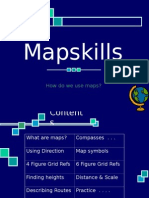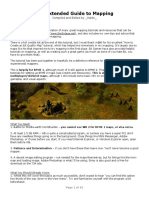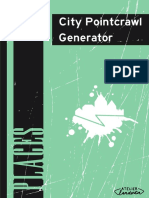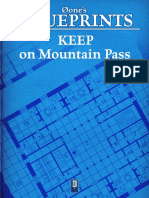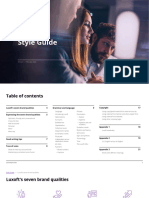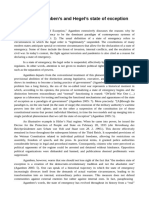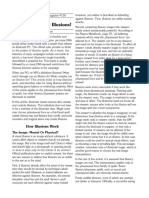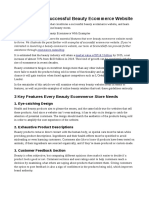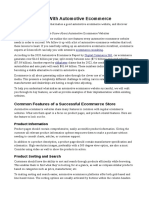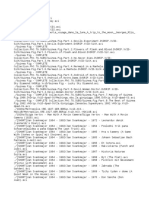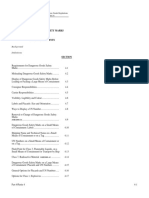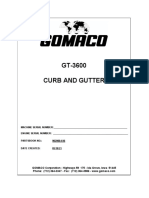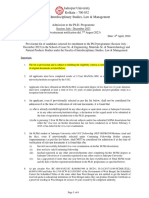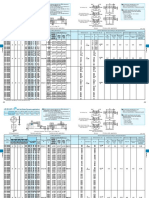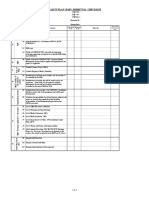MAPPING BASTION
The exact geography of Bastion’s streets is less important than the main routes between key points.
As such, a Borough in Bastion is mapped somewhat like a rail network.
Write as many of your notes directly onto the map as you can manage, keeping only overflow information on a
separate sheet.
ROUTES COMPLICATIONS
○ Using different colours, draw two or more circuits ○ Complications can be simple, like a toll or heavy
denoting different transport routes, ensuring they traffic.
cross over each other.
○ They can be complex such as a hostile environment
○ Add at least one branch off each, in a different colour to navigate, or something to lure the group off-
if you wish. course.
○ Label each different colour as a walkway, tramway, ○ They should always show off the character of Bastion
canal, cable car, or other type of route. and your Borough.
LANDMARKS AND PATHS GOING OFF-GRID
○ Place a dot at each point where routes cross, branch, ○ If the group want to get between two landmarks by a
bend and end. different route, there is always a dark alleyway or
inconvenient short-cut.
○ Name each after a landmark, such as a park or
monument. Note down what might be nearby such ○ The same applies for attempts to explore further
as high-end shops or factory slums. than your map currently extends.
○ For each path between landmarks, detail a ○ Locals know the back routes better than you ever
complication when passing through. will.
NAVIGATION
○ Nobody has a good map of Bastion in its entirety.
○ Boroughs rely on signs and asking for directions.
○ You can give players a copy of the map with details
blacked out.
254
�MAPPING DEEP COUNTRY
The vast spaces of Deep Country are best travelled by established paths, and so can be mapped using route mapping
similar to Bastion, with the following special considerations.
Write as many of your notes directly onto the map as you can manage, keeping only overflow information on a
separate sheet.
ROUTES GOING OFF-ROUTE
○ Using different colours, draw two bending lines that ○ Connect a few unrelated but nearby landmarks with
cross each other. dotted lines, showing they are visible/audible from
each other but have no existing route.
○ Add at least two branches off each, in different
colours if you wish. ○ Roughly label the type of environment that lies in the
empty spaces between routes.
○ Label each different colour as a trail, railway, river, or
other type of route. ○ Add a hazard to each patch of off-route ground,
something that explains why there isn’t a route
there.
LANDMARKS AND PATHS
○ Place a dot at each point where routes cross, branch, NAVIGATION
bend, or end.
○ There are maps somewhere, but most people just
○ Name each after a landmark, such as a ruin, village, or learn their way around.
natural feature. Note the immediate features, with
hidden details in parentheses. ○ As a rule of thumb, landmarks are four hours of
travel apart.
○ For each path in between, detail a flavourful
complication when passing through. ○ Anyone travelling in conditions they are not prepared
for, such as extreme weather, are DEPRIVED until they
take the appropriate precautions.
COMPLICATIONS
○ Complications can be simple, like overgrown plants
or a collapsed bridge.
○ They can be complex, like a lengthy guided trail or a
maze of tunnels through a mountain.
○ They should always reflect the character of this part
of Deep Country.
264
�MAPPING DEEP WATER
Even open waters have currents and winds that act as routes. Use route mapping, with the following special
considerations.
Write as many of your notes directly onto the map as you can manage, keeping only overflow information on a
separate sheet.
CURRENTS
○ Using different colours, draw three circuits that cross
each other.
○ Label each different colour as a current, usually with
an evocative name and visual cue that the group are
riding it.
○ Draw arrows to show the direction of each current.
FEATURES
○ Place an island or other landmark inside each of the
sections of open water surrounded by your
currents.
○ Give each one a name that conjures a clear visual.
Note its immediate features, with hidden details in
parentheses.
○ Draw a two-way shipping lane connecting each island
with the current network, usually as a dotted line.
GOING UPSTREAM
COMPLICATIONS ○ Travelling against the current is possible, but takes
twice as long and always triggers the complication.
○ List a complication for each stretch of current, most ○ Local travellers may know of hidden shortcuts.
often a dangerous encounter or environmental
hazard. ○ There is always more ocean to explore.
○ The complication is triggered in place of an
encounter if the encounter roll demands one.
NAVIGATION
○ If the group return, keep the same complications but
move them around. ○ Local sea travellers have maps and charts but won’t
give the information away for free.
○ As a rule of thumb, each stretch of current between
branching points is a half-day of travel.
○ Anyone travelling in conditions they are not prepared
for, such as extreme weather, are DEPRIVED until they
take the appropriate precautions.
265
�MAPPING THE UNDERGROUND
The Underground uses a similar route mapping system to Bastion, but with the following special notes.
Write as many of your notes directly onto the map as you can manage, keeping only overflow information on a
separate sheet.
ROUTES STRETCHES
○ Using different colours, draw two or more circuits, ○ Passages marked with a spiral are stretches that
ensuring they cross over each other. present a significant distance to cross.
○ Add at least one branch off each, in a different colour ○ Passing through a stretch is rarely the same twice.
if you wish. List 6 possible routes through the stretch, each with
its own encounter.
○ Label each different colour with a theme such as
storm sewers, ornate halls, brass vaults, or ○ When the group enter a stretch roll d6.This is how
maintenance tunnels. many hours it takes to cross and shows the route
and encounter that is triggered inside.
ROOMS AND PASSAGES
NAVIGATION
○ Place a dot at each point where routes cross, branch,
bend, or end, denoting a room. ○ The Underground doesn’t follow the normal rules of
time and space.
○ Give each a name, something easy to conceptualise
like machine shrine or mass tomb. List their ○ Any being that offers directions only directs you to
immediately obvious contents and place details in where they want you to go.
parentheses.
○ You’re never too far from getting back to the surface
○ For each passage between rooms, detail a if you know where to find an exit.
complication when passing through. Leave at least
one passage without a complication and mark it
with a spiral instead.
COMPLICATIONS
○ Complications can be simple, like a steep drop or
mocking vermin.
○ They can be complex, like a death-trap or crease in
space and time.
○ They should always pose a challenge.
274










